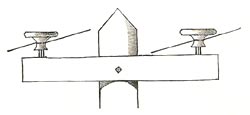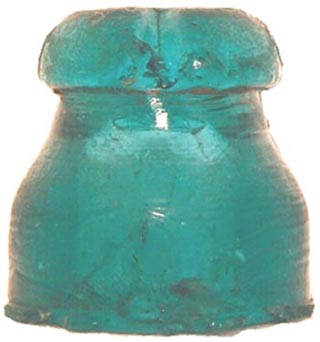
The first pintype insulator known to have been used in this country was the glass bureau knob mentioned in the writings by James Reid. These were used in the construction of the Magnetic Telegraph Company line in 1845. The only example known to exist among insulator collectors at this writing is one found a few years ago by a bottle digger excavating a privy in Norristown, Pennsylvania. The line had reached Norristown in 1845 and was on the route between Philadelphia and New York. The bureau knob is also reported to have replaced the glass plate insulating arrangement which was in use on the original 1844 experimental line between Washington and Baltimore, when the original method was found to have poor insulating ability. An exact date for this replacement of insulation is unknown, but most likely it took place in 1844 or 1845.
James Reid, in his book The Telegraph in America, gives a detailed account of the work:
"The construction of the line was given to Dr. A. C. Goell, and excellent, energetic man, who built, at a subsequent period, most of the lines through southeastern Pennsylvania. Mr. Cornell personally directed the construction from Somerville to Fort Lee. The poles were small and two hundred fee apart. An arm thirty inches long, with a pin at each end, bearing a glass bureau knob, an insulation proposed by Mr. Cornell and approved by Prof. Henry, was secured to the upper end of each pole. Around the bureau knobs the conducting wires were wrapped. The wires were of copper, No. 14, and unannealed. The route of the line was from the Merchants' Exchange, Philadelphia, via the Columbia Railroad to Morgan's Corners, thence to Norristown, Doylestown and Somerville to Fort Lee, by the ordinary wagon road. It seems a singular route for such a grand public purpose between two great commercial cities, but it was the only one then attale, the railroads refusing right of way except on terms deemed too oppressive to be accepted." (p. 116)

Illustration of pole construction with glass bureau knob. The Telegraph in America, p. 116
Early in November 1845 the line was first opened between Philadelphia and Norristown, PA, distant fourteen miles, so as to gratify public curiosity, while the building was going on beyond. The office in Philadelphia was on the second floor of the Merchant's' Exchange. Mr. Alfred Vail, until the completion of the line, had charge. I was his aid." (p. 117)
The line was completed to Fort Lee January 20, 1846. (p. 119)
As soon as the line was complete to Fort Lee our sorrows began. The glass knobs as they glistened in the sun were splendid marks for boys and riffle shooters, and they went by the dozen. There was much ignorance of the purpose of the structure, and, from many causes, the wires broke. Then came summer, and the wires drew out, became attenuated, and gave much trouble.
The first great calamity of the new line, which resulted in the hasty removal of the copper wire, was when one night rain fell through a cold atmosphere and froze upon the wires. The wires looked like two magnificent necklaces glistening with fairy sheen in the beauty of the morning dawn. But a change soon came. In an hour or two a sharp breeze came tipping up from the ocean. The wires swayed awhile to the music of the wind, and looked more beautiful than ever. The wind stiffened, a moment more, and forty miles of wire went down as a breath, every length broken short off at the pole." (p. 121)

CD 780 bureau knob insulator.


CD 784 with top wire groove and vertical notch.
Another item closely resembling the CD 780 bureau knob is the CD 784. This unembossed unit is very similar in shape and molding techniques. Rather than having a wide, mushroom-shaped top, there is a wire groove on top and a vertical notch on each side of the dome.